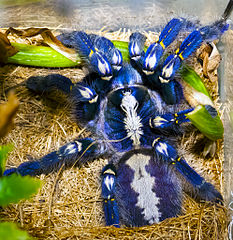Among the world’s 900+ tarantula species (family Theraphosidae) we find a staggering diversity of sizes, colors, and lifestyles, and many that make interesting, long-lived pets. Having been involved with spider care in zoos and private collections from an early age (and at a time when only 1-2 tarantula species were readily available in the USA!), I’m pleased and somewhat astonished to see the explosion of interest here and abroad. Several species that were undescribed a few short years ago are being regularly bred by private keepers – usually to a far greater extent than is seen in zoos. However, as tarantulas become more “mainstream”, they are sometimes purchased by folks who may not have a good sense of their true natures. Unrealistic expectations will dampen the experience of both pet and pet keeper. Following are 5 critical points that the prospective tarantula owner should consider.
Please see the linked articles and post below for detailed care and breeding advice.
Tarantulas are “Hands-Off” Pets that Cannot be Tamed
Like most creatures, Tarantulas are capable of learning, and they routinely modify their behavior in response to captivity. However, they are mainly guided by instinct, and cannot in any way be tamed or “trusted” – they will not bond with people.
Please ignore the foolish advice so common on the Internet and do not handle your tarantula (please post below for info on safely moving tarantulas). Handling is a stressful event for any tarantula. More importantly, while the venom produced by tarantulas has not (as far as we know from published reports) resulted in human fatalities, children, the elderly, and people with allergies or compromised immune systems may be at risk. Please see the article linked below for information on serious reactions caused by the bites of certain Asian tarantulas.
Tarantulas bear urticating (irritating) hairs that are used to repel predators (please see photo). Hairs that come in contact with soft tissue can cause severe injuries. In fact, a Bronx Zoo coworker of mine underwent extensive eye surgery in order to remove Red Kneed Tarantula hairs from his eye. As this person learned, hairs that are in the terrarium or on one’s hands can be just as dangerous as those deliberately shed in response to a threat.
Tarantulas are Nocturnal and Secretive
Well-adjusted tarantulas often emerge to hunt by day, but they will otherwise remain in hiding until nightfall. They will not thrive if forced to remain in the open.
Fortunately, red night-viewing bulbs will enable you to observe your pets after dark.
Your “Single” Tarantula may Surprise You with an Egg Sac
As a single mating can result in multiple egg cases, females sometimes produce eggs long after having been fertilized by a male. If you are not aware of a female’s history, you may find yourself with more tarantula-related responsibilities than you bargained for! While a fascinating endeavor (to me, at least!), rearing 100 or more tiny, cannibalistic spiderlings is not for everyone.
Tarantulas Need Live Food
While many captives learn to take canned insects and pre-killed pink mice from tongs (do not hand-feed!), live insects will form the vast majority of your tarantula’s diet. Cricket-only diets seem to work well for many species, but the best long term results will be achieved by providing a varied menu which includes roaches, waxworms, silkworms, grasshoppers, earthworms and other invertebrates.
The “It Doesn’t Do Anything” Factor
Ideally, the new tarantula owner will be interested in her or his pet for its own sake. But most of us also wish to see how the animal lives, what it does, and so on. Well-fed tarantulas that are not in breeding mode are often about as active as the infamous “pet rock”…and are nocturnal to boot!
Fortunately, red light bulbs now enable us to watch them after dark. If you provide your tarantula with a large terrarium and appropriate living conditions, you’ll have much of interest to observe.
Further Reading
 That Reptile Blog – Reptile, Amphibian and Exotic Pet Care and Information
That Reptile Blog – Reptile, Amphibian and Exotic Pet Care and Information







I read recently on http://www.pet-tarantulas.com that Brazilian black tarantulas are one of the most docile species, but also one of the most difficult to find species in the U.S., have you found this to be true?